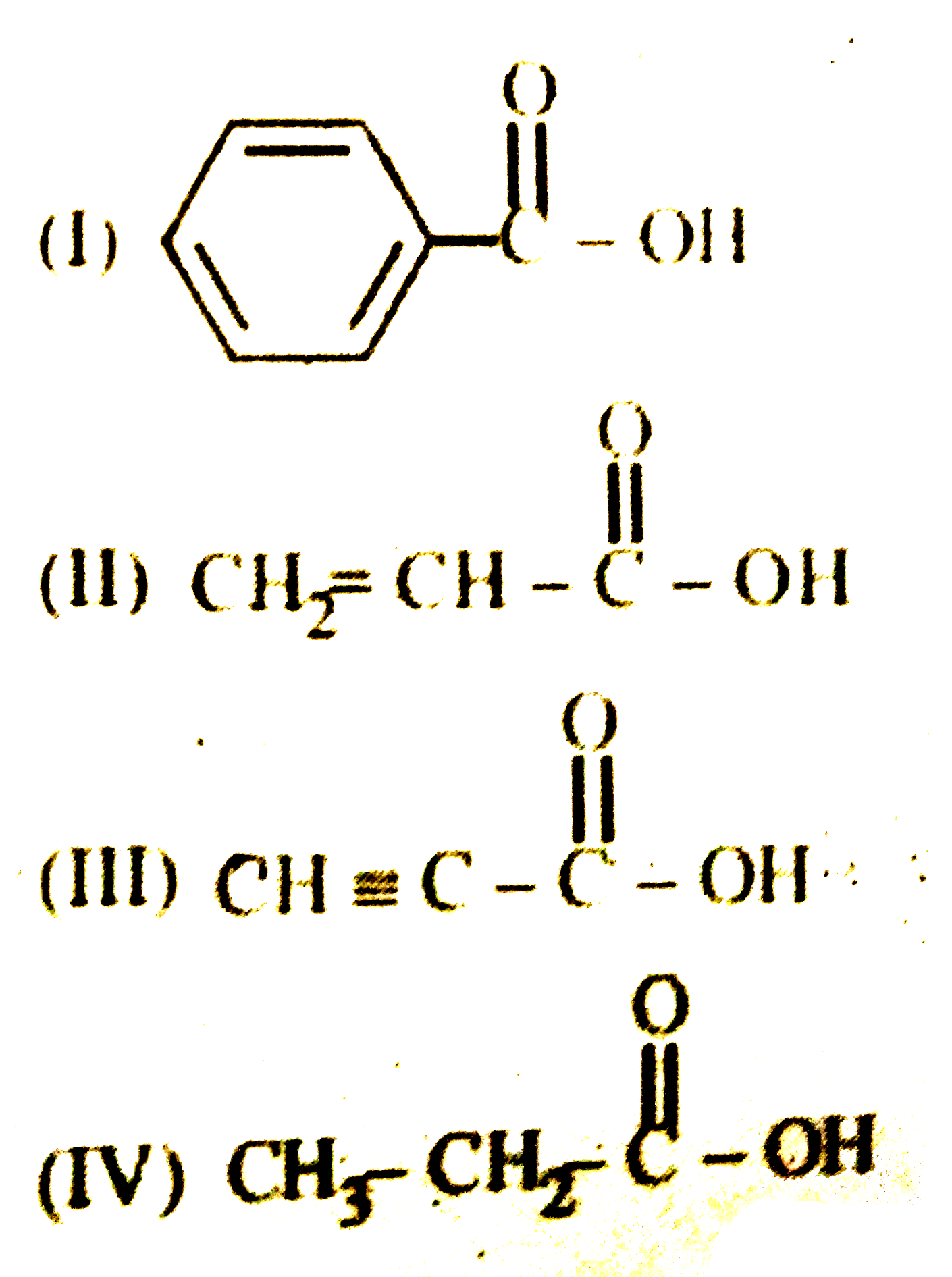Which of the following acts as a nucleophilie in the Cannizzaro reaction involving benzaldehyde ?
(i) OH− (ii) −C6H4COH
(iii) C6H5CH(OH)O− (iv) H2⋅⋅O:
(i) and (iv)
(i) and (ii)
(i) and (iii)
only (i)
The correct Answer is:C
To determine which species acts as a nucleophile in the Cannizzaro reaction involving benzaldehyde, we need to analyze each option provided.
1. Understanding the Cannizzaro Reaction:
The Cannizzaro reaction occurs with aldehydes that do not have alpha hydrogens. Benzaldehyde (C₆H₅CHO) is one such aldehyde. In this reaction, one molecule of benzaldehyde is oxidized to benzoic acid, while another molecule is reduced to benzyl alcohol.
2. Identifying Nucleophiles:
In the Cannizzaro reaction, a nucleophile attacks the carbonyl carbon of the aldehyde. The common nucleophile in this reaction is the hydroxide ion (OH⁻).
3. Analyzing Each Option:
- (i) OH⁻: This is a hydroxide ion, which is a strong nucleophile and can attack the carbonyl carbon of benzaldehyde.
- (ii) C₆H₄COH: This represents a benzyl alcohol structure. While it can participate in the reaction, it is not a nucleophile in the context of the Cannizzaro reaction.
- (iii) C₆H₅CH(OH)O⁻: This is a species that can act as a nucleophile due to the presence of the negatively charged oxygen. It can also participate in the reaction.
- (iv) H₂O: Water is a very weak nucleophile and does not effectively participate in the Cannizzaro reaction.
4. Conclusion:
The species that acts as a nucleophile in the Cannizzaro reaction involving benzaldehyde are:
- (i) OH⁻
- (iii) C₆H₅CH(OH)O⁻
Thus, the correct options are (i) and (iii).
Final Answer:
The nucleophiles in the Cannizzaro reaction involving benzaldehyde are (i) OH⁻ and (iii) C₆H₅CH(OH)O⁻.
---
The Cannizzaro reaction occurs with aldehydes that do not have alpha hydrogens. Benzaldehyde (C₆H₅CHO) is one such aldehyde. In this reaction, one molecule of benzaldehyde is oxidized to benzoic acid, while another molecule is reduced to benzyl alcohol.
In the Cannizzaro reaction, a nucleophile attacks the carbonyl carbon of the aldehyde. The common nucleophile in this reaction is the hydroxide ion (OH⁻).
- (i) OH⁻: This is a hydroxide ion, which is a strong nucleophile and can attack the carbonyl carbon of benzaldehyde.
- (ii) C₆H₄COH: This represents a benzyl alcohol structure. While it can participate in the reaction, it is not a nucleophile in the context of the Cannizzaro reaction.
- (iii) C₆H₅CH(OH)O⁻: This is a species that can act as a nucleophile due to the presence of the negatively charged oxygen. It can also participate in the reaction.
- (iv) H₂O: Water is a very weak nucleophile and does not effectively participate in the Cannizzaro reaction.
The species that acts as a nucleophile in the Cannizzaro reaction involving benzaldehyde are:
- (i) OH⁻
- (iii) C₆H₅CH(OH)O⁻
The nucleophiles in the Cannizzaro reaction involving benzaldehyde are (i) OH⁻ and (iii) C₆H₅CH(OH)O⁻.
Topper's Solved these Questions
- BOOK - DISHA PUBLICATIONCHAPTER - ALDEHYDES, KETONES AND CARBOXYLIC ACIDSEXERCISE - Exercise - 1 : Concept Builder (Topicwise) (TOPIC 2 : Properties of Carbonyl Compounds)36videos
ALDEHYDES, KETONES AND CARBOXYLIC ACIDS
- BOOK - DISHA PUBLICATIONCHAPTER - ALDEHYDES, KETONES AND CARBOXYLIC ACIDSEXERCISE - Exercise - 1 : Concept Builder (Topicwise) (TOPIC 3 : Preparation and Properties of Carboxylic Acids)21videos
ALDEHYDES, KETONES AND CARBOXYLIC ACIDS
- BOOK - DISHA PUBLICATIONCHAPTER - ALDEHYDES, KETONES AND CARBOXYLIC ACIDSEXERCISE - Exercise - 2 : Concept Applicator27videos
ALDEHYDES, KETONES AND CARBOXYLIC ACIDS
- BOOK - DISHA PUBLICATIONCHAPTER - ALCOHOLS, PHENOLS AND ETHERSEXERCISE - Exercise - 2 : Concept Applicator)28videos
ALCOHOLS, PHENOLS AND ETHERS
- BOOK - DISHA PUBLICATIONCHAPTER - AMINESEXERCISE - Exercise - 2 : Concept Applicator30videos
AMINES
Similar Questions
Knowledge Check
- Question 1 - Select One
In the Cannizzaro reaction given below
2C6H5CHOOH−−−→C6H5CH2OH+C6H5COO−
the slowest step isAattack of OH− at the carbonyl group.Btransfer of hydride ion to the carbonyl group.Cabstraction of proton from the carboxylic acid.Dfeprotonation of C6H5CH2OH. - Question 2 - Select One
Which of the following is pseudo first order reaction?
I. CH3COOC2H5+H2OH+−−→CH3COOH+C2H5OH
II. C12H22O11+H2OH+−−→C6H12O6+C6H12O6Aonly IBonly IICboth I & IIDnone of these - Question 3 - Select One
In the given Cannizzaro reaction, the slowest step is:
2C6H5CHOOH−−→C6H5CH2OH+C6H5COO−AThe attack by OH on the carbonyl group.BThe transfer of the hydride to the carbonyl group.CThe exchange of protons can be slow steps.DAll the above.
Given the products in each of the following reactions :
(i) H3C−CH2−O∣∣C−CH3C6H5−CO3H−−−−−−−−→,C2H5Ona−−−−−→H+
(ii) H3C−CHOC6H5−CO3H−−−−−−−−→CH3−CH2ONa−−−−−−−−−→H+
(iii) H3C−C≡CHHgSO4/H2SO4−−−−−−−−−→,C6H5−CO3H−−−−−−−−→CH3ONa−−−−−→H+View SolutionPredict the products of the following reactions :
(i) CH3−CH=CH2(i)B2H6−−−−−−−−−−−−→(ii)3H2O2/OH−
(ii) C6H5−OHBr2(aq)−−−−→
(iii) CH3−CH2−OHCu/573K−−−−−→View SolutionArrange the following in order of their reactivity toward decarboxylation with sodalime
(i)
(ii) CH2=CH−O∣∣C−OH
(iii) CH≡C−O∣∣C−OH
(iv) CH3−CH2−O∣∣C−OHView SolutionWhich of the following can give iodoform test?
(I) CH3−O∣∣C−CH2−O∣∣C−CH3
(II) C6H5−CH2−O∣∣C−CH3
(III) CH3−CHO
(IV) C6H5−O∣∣C−CH3View SolutionFor the following acids the rate of decarboxylation on heating would be
I.CH6H5−O∣∣C−CH2−COOH (II)C6H5−O∣∣C−COOH
III.CH3−CH2−COOH IV.HOOC−CH2−COOHView Solution


